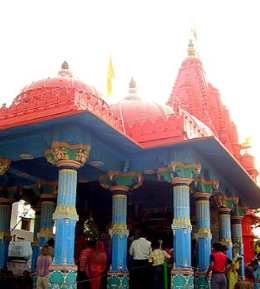BRAHMA TEMPLE(PUSHKAR,RAJASTHAN) AND ITS HISTORY
Jagatpita Brahma Mandir is a Hindu sanctuary arranged at Pushkar in the Indian territory of Rajasthan, near the hallowed Pushkar Lake to which its legend has a permanent connection. The sanctuary is one of not many existing sanctuaries devoted to the Hindu maker god Brahma in India and remains the most unmistakable among them.
The sanctuary structure dates to the fourteenth century, somewhat revamped later. The sanctuary is made of marble and stone chunks. It has a particular red zenith (shikhara) and a hamsa winged animal theme. The sanctuary sanctum sanctorum holds the picture of four-headed Brahma and his partner Gayatri(goddess of milk).
The sanctuary is depicted to have been worked by sage Vishwamitra after Brahma's yagna (ritual). It is likewise accepted that Brahma himself picked the area for his sanctuary. The eighth-century Hindu thinker Adi Shankara remodeled this sanctuary, while the current middle age structure dates to Maharaja Jawat Raj of Ratlam, who made increments and fixes, however, the first sanctuary configuration is retained.
Pushkar is frequently portrayed in the sacred texts as the main Brahma sanctuary on the planet, attributable to the scourge of Savitri(Saraswati), and as the "Ruler of the consecrated spots of the Hindus".Although now the Pushkar sanctuary doesn't remain the main Brahma sanctuary, it is as yet one of not many existing sanctuaries devoted to Brahma in India and the most noticeable one committed to Brahma.
HISTORY :
As indicated by the Hindu sacred writing Padma Purana, Brahma saw the devil Vajranabha attempting to murder his kids and bugging individuals. He quickly slew the evil presence with his weapon, the lotus-blossom. In this cycle, the lotus petals fell on the ground at three spots, making 3 lakes: the Pushkar Lake or Jyeshta Pushkar, the Madya Pushkar Lake, and Kanishta Pushkar lake.
At the point when Brahma came down to the earth, he named where the bloom ("Pushpa") tumbled from Brahma's hand ("kar") as "Pushkar". Brahma at that point chose to play out a yajna at the principle Pushkar Lake. So as to play out his yajna calmly without being assaulted by the evil spirits, he made the mountains around the Pushkar – Ratnagiri in the south, Nilgiri in the north, Sanchoora in the west, and Suryagiri in the east and situated divine beings there to ensure the yajna execution. Notwithstanding, while at the same time playing out the yajna, his better half Savitri (Saraswati)could not be available at the assigned chance to play out the fundamental aspect of the yajna as she was hanging tight for her buddy goddesses Lakshmi, Parvati, and Indrani.
Irritated/Annoyed, Brahma mentioned god Indra(the lord of paradise) to locate a reasonable young lady for him to marry to finish the yajna. Indra could discover just a Gujar's girl (a milkmaid) who was purified by going her through the body of a bovine. Divine beings Vishnu, Shiva, and the clerics confirmed her immaculateness as she had gone through a cow, it was her subsequent birth and she was named Gayatri (goddess of milk). Brahma at that point wedded Gayatri and finished the yajna with his new partner sitting adjacent to him, holding the pot of amrita on her head and giving ahuti (offering to the conciliatory fire). Yet, when Savitri, at last, showed up at the scene she discovered Gayatri sitting close to Brahma which was her legitimate spot. Fomented, she reviled Brahma that he would be rarely worshipped, however then diminished the revile allowing his love in Pushkar. Savitri likewise reviled Indra to be effectively crushed in fights, Vishnu to experience the ill effects of his better half as a human, the Agni(fire-god ) who was offered the yajna to be all-eating up and the ministers administering the yajna to be poor.
By the forces of yajna, Gayatri weakened Savitri's revile, favoring Pushkar to be the ruler of journeys, Indra would consistently hold his paradise, Vishnu would be conceived as the human Rama lastly join with his partner and the ministers would become researchers and be worshiped. Subsequently, the Pushkar sanctuary is respected as the main sanctuary committed to Brahma. Savitri, from that point, moved into the Ratnagiri slope and turned into a piece of it by rising as a spring known as the Savitri Jharna (stream); a sanctuary in her honor exists here.

